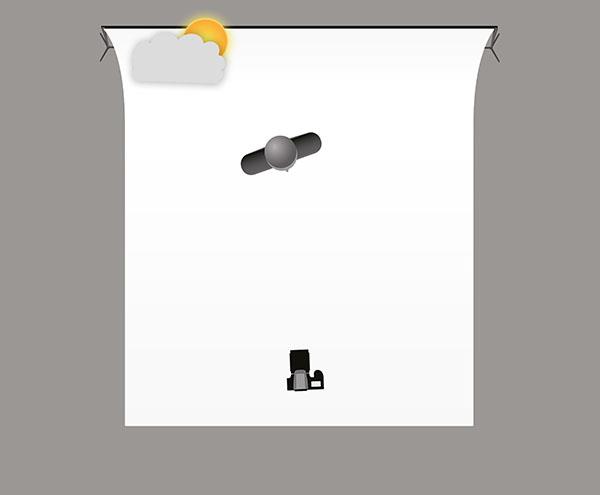What’s the Difference? is a series of video lighting tutorials. Each episode responds to a single question. In this episode, Jared Platt compares shooting with and without Profoto High-Speed Sync (HSS). The entire series, including all videos, articles and lighting diagrams, is available at our website.
We had a great idea for a lighting challenge: take a bride and groom out on the sand dunes and make beautiful and dramatic portraits under the harsh sun using Profoto High-Speed Sync (HSS) to control the ambient light.
So, we headed out to the desert. The weather reported clouds and a 20% chance of rain, which in the desert means an 80% chance of nothing and another 20% chance of pretty much nothing. But when we arrived at our location, the weather reports did not match the scene before us. The clouds were thick and the wind was cold. We knew we were going to get rain very soon. But we had driven over three hours for this shot. So had our bride and groom. So we got out on the dunes and made the shot as quickly as possible.
Ambient Light
While we had expected fluffy clouds floating through blue skies and overly bright sand dunes to be our challenge, the ambient exposure of the thick grey rain clouds was just as challenging. Exposing for the bride left the skies and the sand far too bright to be interesting. Adding drama to the shot required the overall ambient exposure to drop. But that lowered the exposure on the bride as well! So a flash was needed. But not any flash would do. We needed a flash that could sync to a shutter speed of 1/500 of a second.


Using High-Speed Sync (HSS)
Once our exposure settings goes above a shutter speed of 1/200 second, a flash with High-Speed Sync (HSS) is required.
Many photographers will use an HSS enabled speedlight for this. But doing so, they often battle with inconsistent exposures, limited power and slow recycle times.
There are reasons for this. In HSS Mode, the flash must fire a great number of times during the short shutter window in order to expose the film or chip evenly across the frame. This means that the flash must be able to deliver a powerful burst of light with a very short duration, and repeat that over and over again, all within 1/500 of a second or faster. A typical speedlight doesn’t have the horse power to make this happen. If it does, it slows the recycle times down to a crawl. Add a bit of distance and a softbox to the equation, and a speedlight just crashes and burns.
A Profoto off-camera flash, on the other hand, packs a lot of power and recycles fast enough to give you that same power each time you fire.
During our ambient exposure (1/400 sec, ISO 200 at f 4), we lost the sky in order to correctly expose the girl. With flash employed, we could choose a better ambient exposure, a whole 1.3 stops darker than the original exposure (1/500 sec, ISO 100 at f 4), to capture a darker, more ominous sky. Then, we simple added our Profoto B2 and set it to HSS Mode to fill in the bride’s body and face.
Keep in mind that HSS is not sorcery! It operates on physics and science, just the way the rest of your camera equipment does. Once you get to know HSS, you can predict how it will react.
Here are a few reminders as you start using HSS:
- HSS burns through batteries.
Because HSS is an intense rapid fire of flashes, it uses a lot more battery power. So plan accordingly. Use HSS when needed. Turn it off when you don’t need it. - Aperture still effects flash power.
HSS does not change a flash’s relationship to the f-stop. Open that aperture and let in more of that beautiful flash light! (Notice our aperture was at f 4.) - Check you distance.
Flash falls off quickly, so keep your flash as close to the subject as you can without getting it in the shot. The closer your flash is, the less power you need to create the same light. And as a bonus, you will get softer light. - ISO still effects flash power.
The higher you can push your ISO on a shot, the further your flash will travel and the less battery you will have to burn to create the light you want. Get to know your grain structure. Decide where your sweet spots are and how far you are willing to extend the life or increase the power of your flash. - Shutter speed counts.
This is a strange one, because you have always been taught that the shutter speed only affects the ambient exposure and that the flash exposure is only controlled by ISO, aperture, flash power settings and its distance to the subject. Well, things change a little with HSS. For the most part, the shutter speed controls the ambient, but you will notice an interesting relationship between the flash and the shutter speed when you are pushing the shutter speed envelope with HSS. Essentially, HSS is accomplished by flashing the strobe so fast that it is essentially a very bright, constant light source that turns on as the shutter opens and turns off once the shutter is completely closed. Because the shutter is moving during this “constant exposure”, the flash exposure does not create a shadow across the chip (or the film). To understand this, just think about a completely ambient exposure, it doesn’t create a shadow because the light is constantly on and the shutter curtain is moving during the exposure. HSS is doing the same thing by strobing extremely fast to mimic constant light. When you double the shutter speed from 1/500 sec. to 1/1000 sec., the opening in the shutter curtain is half the width, so the chip will only see the light for half the total time and therefore, the flash’s portion of the exposure will be half as bright. Understanding this, keep your shutter speed as low as you can and still accomplish your shutter speed goals. Don’t set your camera at 1/4000 sec. if you don’t need that shutter speed because in this brave new HSS world, shutter speed is not autonomous.
On-Camera Flash
The Profoto B2 is small and light enough to be used on-camera. It doesn’t attach into the hot shoe like a speedlight, so a bracket that leaves room for the Profoto Air Remote is necessary.
I don’t typically shoot with on-camera flash, but in this case we wanted to demonstrate this shot without the need for an assistant. So we put the flash on-camera. The exposure is the same. Only the direction of light and volume of the subject changes.


Off-Camera Flash
Once the decision was made to take the flash off-camera, the position of that light was based on what would make the subject look better. In this case, a forty-five degree angle from the bride worked to provide a short-light, which slims her face and body, while the cross light brings out the texture in the dress (which is lost in the on-camera flash example). You can also see that we roughly followed the lighting cues from the ambient light around her. The shadows and lighting patterns on her face follow the same general direction as the shadows and lighting patterns on the sand dunes.
The final image was shot with the Profoto B2 off to the right of the camera, modified with a Profoto OCF Softbox 2×3′ on a tall monopod. Using a softbox was essential to keep the light soft enough to match the soft light all around her. The OCF Softbox 2×3′ was particularly useful in this shot because it is light and easier to handle in a windy circumstance such as this.
The ambient exposure was 1/500 sec (well over the camera sync speed, which is why High-Speed Sync was necessary). With a softbox modifying the light and a distance to the subject of at least twenty feet, a typical speedlight would have had a difficult time providing the power necessary. But the Profoto B2 had the power to travel the distance, light up the modifier and it recycled fast enough to keep us shooting rapidly in a very cold and rapidly deteriorating situation.


Conclusion
High-Speed Sync (HSS) is all about being in control of the light. In other words, having HSS as an option allows you to choose your exposure settings based on your artistic intent rather than the weather forecast.
Set your shutter speed as high as you need to, your aperture as wide as want to, and your ISO in your favorite sweet spot. Add your Light Shaping Tools of choice and sculpt the shot exactly the way you envisioned it.
Watch more video lighting tutorials in this series
Learn more about the Off-Camera Flash system
Thanks,
Jared Platt